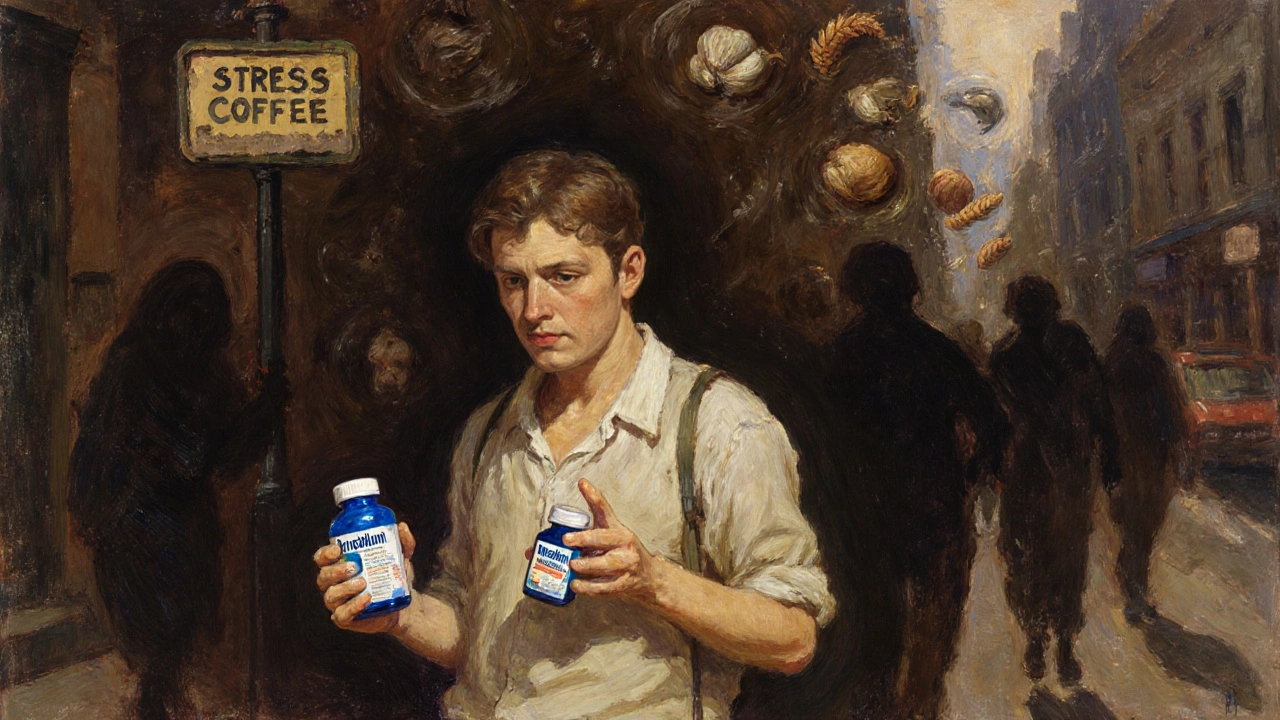What Is IBS-Mixed?
IBS-Mixed, or IBS-M, is a type of irritable bowel syndrome where you switch between constipation and diarrhea - sometimes within the same day. It’s not just occasional tummy trouble. To be diagnosed, you need abdominal pain at least once a week for three months, along with changes in stool form or frequency. You’ll have hard, lumpy stools (Bristol Scale 1-2) and loose, watery stools (Bristol Scale 6-7) in at least 25% of your bowel movements. Unlike Crohn’s or colitis, there’s no inflammation or damage to your intestines. Instead, your gut is overly sensitive, moves too fast or too slow, and your gut bacteria are out of balance.
It’s more common than you think. About 1 in 5 people with IBS have this mixed form. That means if you’re dealing with unpredictable bowel habits, you’re not alone. But it’s also one of the hardest to manage because what helps one day might make things worse the next.
Why Is IBS-Mixed So Hard to Treat?
Most IBS medications target one direction: either constipation or diarrhea. But IBS-Mixed throws both at you. Take a laxative for constipation? It might trigger a diarrhea flare. Use loperamide (Imodium) for diarrhea? Now you’re stuck. This back-and-forth makes treatment feel like walking a tightrope.
Studies show that drugs made for IBS-C or IBS-D work poorly for IBS-M. For example, linaclotide helps about 48% of IBS-C patients but only 22% of those with IBS-M. Eluxadoline helps 38% of IBS-D patients but only 19% of IBS-M. That’s why doctors rarely rely on one pill alone. The goal isn’t to cure - because there’s no cure - but to stabilize your system enough to live without constant fear of the next episode.
Track Your Symptoms Like a Pro
You can’t fix what you don’t measure. The first step is tracking: what you eat, when you have pain, how your stool looks, and how stressed you feel. Use the Bristol Stool Scale to rate your bowel movements - 1-2 means constipation, 6-7 means diarrhea. Rate pain from 0 to 10. Note any triggers: dairy, caffeine, stress, or even a bad night’s sleep.
People who use apps like Cara Care or a simple notebook see 35% better results than those who guess what’s causing their symptoms. Why? Because patterns hide in plain sight. You might think gluten is the culprit, but it’s actually the garlic in your pasta sauce - a FODMAP. Or maybe your diarrhea flares after coffee on Sundays, not because of caffeine, but because you skip breakfast and stress about the weekend.
Track for at least four weeks. Don’t skip days. Even if you feel fine, write it down. That data becomes your roadmap.
The Low FODMAP Diet: What Works and What Doesn’t
The low FODMAP diet is the most studied and effective dietary approach for IBS-M. FODMAPs are short-chain carbs that ferment in your gut and cause gas, bloating, and erratic bowel movements. Common ones include onions, garlic, wheat, dairy, apples, and artificial sweeteners.
Research shows 50-60% of IBS-M patients improve on this diet - slightly less than IBS-D patients, but still significant. The key is structure: eliminate high-FODMAP foods for 2-6 weeks, then slowly reintroduce them one at a time. This isn’t about cutting out forever. It’s about finding your personal triggers.
For example, one person finds lactose-free milk fine but can’t tolerate avocado. Another handles onions but breaks out after eating lentils. A registered dietitian who specializes in IBS can guide you through this. Doing it alone often leads to unnecessary restrictions or missed triggers.
Reddit users on r/IBS report that 62% found low FODMAP helpful, with many seeing results in 4-6 weeks. One user cut symptom days from 25 to 8 per month after adding peppermint oil capsules. But don’t expect miracles overnight. It takes patience - and a lot of label reading.

Medications: How to Use Them Without Making Things Worse
There’s no magic pill for IBS-M. But smart, flexible use of meds can help you stay in control.
- For diarrhea: Loperamide (Imodium) - take 2-4 mg only during flares. Don’t use daily. Overuse can lead to constipation or worse, bowel obstruction.
- For constipation: Polyethylene glycol (Miralax) - 17g daily is safe for regular use. Unlike stimulant laxatives, it doesn’t cause dependency or cramping.
- For pain and bloating: Dicyclomine (Bentyl) - 10-20 mg up to four times a day. Helps calm spasms. Side effects: dry mouth, dizziness.
- For pain and brain-gut connection: Low-dose tricyclic antidepressants (like amitriptyline 10-25 mg at night). Not for depression. They quiet nerve signals in the gut. Studies show 55-60% of IBS-M patients improve. Better than SSRIs for pain.
- For bloating: Enteric-coated peppermint oil (IBgard) - 2 capsules twice daily. Reduces pain and gas in 68% of users. Avoid if you have GERD - it can cause heartburn.
The trick? Keep both meds on hand - one for constipation, one for diarrhea - and use them based on what your body needs that day. Don’t take them prophylactically. Let your symptoms guide you.
Stress Is Not Just in Your Head - It’s in Your Gut
Stress doesn’t cause IBS-M, but it turns up the volume. A 2019 study found 68% of IBS-M patients say stress makes symptoms worse. That’s not coincidence. Your gut has its own nervous system - the enteric nervous system - and it talks directly to your brain.
That’s why cognitive behavioral therapy (CBT) is a first-line treatment. A 2021 review of 12 trials showed CBT reduced IBS symptoms by 40-50%. It doesn’t fix your gut. It teaches your brain to stop overreacting to gut signals. Online programs like the Monash University IBS app or the IBS Self-Help Program by the University of North Carolina have proven results.
Other stress-reduction tools work too: daily breathing exercises, yoga, or even 20 minutes of walking outside. One user on HealthUnlocked said combining dicyclomine with daily meditation cut her flare-ups in half. You don’t need to meditate for an hour. Just 5 minutes when you wake up - and 5 minutes before bed - can reset your nervous system.
What to Avoid - and What to Try Instead
Here’s what most people with IBS-M try - and why it backfires:
- Overdoing fiber: Insoluble fiber (wheat bran, whole grains) can trigger bloating and cramps. Try soluble fiber instead - psyllium husk (5g daily). It softens stool without gas.
- Skipping meals: Irregular eating throws off gut motility. Eat at consistent times. Even if you’re not hungry, have a small snack.
- Drinking alcohol or soda: Both irritate the gut and worsen alternating symptoms. Swap soda for sparkling water with lemon.
- Self-diagnosing gluten intolerance: Many think they’re gluten-sensitive. But in IBS-M, it’s often fructans in wheat, not gluten. Try low-FODMAP gluten-free bread instead of assuming you need to go completely gluten-free.
- Using probiotics blindly: Not all probiotics help. Look for strains backed by research: Bifidobacterium infantis 35624 (Align) or the combination in VSL#3. Avoid random store-bought brands.

What’s New in IBS-M Treatment?
Science is moving fast. In 2023, the FDA approved a new drug called ibodutant - a neurokinin-2 receptor antagonist - that showed 45% symptom improvement in IBS-M patients, compared to 28% with placebo. It’s not on the market yet, but it’s a sign that targeted treatments are coming.
Microbiome testing is also gaining ground. Viome’s Gut Intelligence test uses AI to analyze your gut bacteria and gives personalized food recommendations. In a 2023 pilot study, users saw 58% symptom improvement. It’s expensive ($299), but for those who’ve tried everything, it’s a potential game-changer.
The Rome V criteria, expected in 2024, will raise the bar for diagnosis: you’ll need alternating symptoms in 30% of bowel movements instead of 25%. That means more precise diagnosis - and better-targeted care.
Real Talk: What Works in Real Life
Here’s what people with IBS-M actually do to get their lives back:
- Keep Miralax and Imodium in your bag, purse, or car - always.
- Start meals with a small portion of soluble fiber (like oatmeal or chia pudding).
- Use peppermint oil capsules before meals if bloating is a problem.
- Plan outings around bathroom access. Know where restrooms are. It reduces anxiety.
- Don’t wait until you’re in pain to take dicyclomine. Take it at the first sign of cramping.
- On high-stress days, skip caffeine and eat simple, low-FODMAP meals: grilled chicken, rice, carrots, bananas.
- Join a support group. Reddit, HealthUnlocked, or IBS Network UK offer real stories - not just medical jargon.
One man, 42, said after 7 years of misdiagnosis, he finally got control by combining low FODMAP, daily psyllium, and 10 mg of amitriptyline at night. His symptom days dropped from 20 to 5 per month. He still has bad days - but now he knows how to handle them.
When to See a Doctor - And What to Ask
You should see a gastroenterologist if:
- Your symptoms started after age 50
- You’re losing weight without trying
- You have blood in your stool
- You have a family history of colon cancer or IBD
Before your appointment, bring your symptom diary. Ask: “Could this be IBS-M?” and “Should I try the low FODMAP diet with a dietitian?” Don’t accept a dismissal. IBS-M is real, and it’s treatable - but you need a doctor who listens.
Insurance often covers dietitian visits and CBT. Ask your provider. Many employers now offer IBS management programs through health benefits. Check your plan.
Final Thought: You’re Not Broken
IBS-Mixed doesn’t mean your gut is failing. It means your gut is hypersensitive - and your nervous system is stuck in overdrive. You’re not lazy. You’re not imagining it. You’re not failing at dieting. You’re managing a complex, misunderstood condition.
Progress isn’t linear. Some weeks you’ll feel great. Others, you’ll be stuck on the toilet. That’s normal. The goal isn’t perfection. It’s control. You can live well with IBS-M. It takes time, tracking, and patience - but thousands have done it. You can too.







Comments(8)